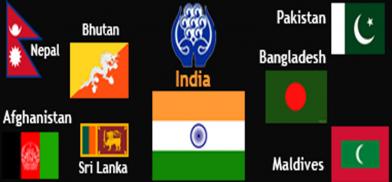India and SAARC: Need to re-set engagement with key partners
If India is to defend its turf against China in the SAARC region, it must contribute to greater flows of intra-regional trade and investments by accepting “asymmetrical responsibilities” in opening its market to neighbours without insisting on reciprocity, writes N Chandra Mohan for South Asia Monitor

Thirty-five years after the South Asian Association for Regional Cooperation (SAARC) came into existence, persisting political tensions between Pakistan and India cast a long and troubling shadow over this grouping.
Not surprisingly, there were negligible outcomes at the recent informal meeting of SAARC foreign ministers when India’s External Affairs Minister S Jaishankar targeted Pakistan by flagging cross-border terrorism, blocking connectivity, and obstruction of trade as key challenges confronting this grouping. For such reasons, India scuppered a proposal to hold the 19th SAARC summit in Islamabad that has been stalled since 2016.
SAARC no longer a priority for India?
Due to the P-factor, SAARC has receded from the priorities of India’s Prime Minister Narendra Modi in favour of the Bay of Bengal Initiative for Multi-Sectoral Technical and Economic Cooperation (BIMSTEC). BIMSTEC’s allure is that it includes much of the neighbourhood minus Pakistan.
The exigencies of combatting the viral pandemic, however, provided PM Modi an opportunity to re-connect with SAARC leaders after a long gap through video on March 15. Health ministers had a follow-up meeting on April 23. Regional finance ministers, too, had a virtual conference on September 16. But a full-fledged SAARC summit is not on.
Neither is a full-fledged South Asian Free Trade Agreement (SAFTA), the free trade arrangement of the SAARC, for that matter. What sort of regional integration is possible when Pakistan and India do not extend the most favoured nation (MFN) status to one another? The most favoured nation status is foundational to any trading agreement as it entails extending equal treatment to all trade partners. As these two neighbours do not have normal trading relations and with poor connectivity in the region, trade within South Asia is perhaps the lowest in the world.
Indian cannot de-prioritise SAARC
India’s challenge, however, is that it simply cannot de-prioritise SAARC as China has made deep inroads in terms of trade and investments.
If India is to defend its turf against China in the SAARC region, it must contribute to greater flows of intra-regional trade and investments by accepting “asymmetrical responsibilities” in opening its market to neighbours without insisting on reciprocity, to borrow an expression of former prime minister Manmohan Singh in his address at the 14th SAARC summit in New Delhi in 2007.
As the dominant economic power, India must foster greater regional cooperation. Even if it cannot match the dragon in cheque book diplomacy, it must harness its soft power to help the neighbourhood combat the viral outbreak through its affordable medicines and healthcare delivery through credible public health institutions.
India’s challenges in South Asia
India’s challenges are most evident in Bangladesh. China is the largest trading partner of this neighbouring country. It granted duty-free access to 97 percent of its exports in June. India’s recent ban on onion exports and resumption of pre-contracted shipments after Bangladesh protested contrasts sharply with the dragon’s more open-ended trading stance.
Four years ago, China’s President Xi Jinping visited Bangladesh and promised USD 20 billion of investments in 27 infrastructural projects. The dragon’s net foreign inflows are ten-times higher than India’s USD 114 million in 2018-19 that ends on June 30, according to Bangladesh Bank.
To be sure, PM Modi wanted to visit Bangladesh in March but it was postponed. Of late, the island nation of Maldives has received focused attention. In his address to the SAARC foreign ministers meeting, Maldives’ Abdulla Shahid mentioned that the financial assistance of USD 250 million pledged by India as the largest support package announced by a bilateral partner during COVID-19. India is also the single largest donor of Maldives with USD 1.4 billion received in 2018 and cash grants for various community projects. A cargo ferry service has also been recently started between India and Kulhuduffushi port in the Maldives to herald a new era of shipping between the two countries.
India’s neighbourhood policy
PM Modi’s virtual summit with his Sri Lankan counterpart Mahinda Rajapaksa exemplifies the thrust of India’s neighbourhood policy and the doctrine of security and growth for all in the region. A re-set in relation is being attempted which could be an exemplar for India’s ties with other SAARC members. India urged Sri Lanka’s premier to address the aspiration of Tamils; discussed infrastructure and connectivity projects; promised USD 15 million for promoting Buddhist ties and restart trade and tourism. However, India has still not acceded to Sri Lanka’s request for a three-year debt moratorium and USD 1 billion bilateral currency swap.
Unilateral measures on trade and investments are the way forward for India to re-set its engagement with South Asia. Instead of worrying over Sri Lanka’s temporary restrictions on the import of a few products, India could have signalled intent to finalise the Economic and Technology Cooperation Agreement which is a much broader version of the existing bilateral free trade agreement.
Pursuing sub-regional cooperation in South Asia – for example, between five southern Indian states and Sri Lanka - suggested by former Sri Lankan PM Ranil Wickremesinghe at The Hindu’s thought enclave earlier this year is also a worthwhile idea whose time has come to at least partially integrate the region.
(The writer is an economics and business commentator based in New Delhi. His views are personal)
And i am satisfied studying your article. But want to remark on some common things, The website style is wonderful, the articles is in reality nice : D.
Just right job, cheers
casino en ligne
Today, I went to the beach front with my children. I found a sea shell
and gave it to my 4 year old daughter and said "You can hear the ocean if you put this to your ear."
She placed the shell to her ear and screamed. There was a hermit crab inside and it pinched her ear.
She never wants to go back! LoL I know this is entirely off topic but I had to tell someone!
casino en ligne
Hello to every one, because I am truly eager of reading this website's post to be updated regularly.
It consists of fastidious stuff.
casino en ligne
Whats up are using Wordpress for your blog platform?
I'm new to the blog world but I'm trying to get started and
set up my own. Do you require any coding expertise to make your
own blog? Any help would be really appreciated!
casino en ligne
This is a topic that's close to my heart... Best wishes!
Where are your contact details though?
casino en ligne
Excellent goods from you, man. I have have in mind your stuff prior to and you are simply extremely fantastic.
I really like what you have received right here,
certainly like what you are stating and the way in which you say it.
You're making it enjoyable and you continue to care for
to keep it wise. I can't wait to read much more
from you. That is actually a wonderful website.
casino en ligne
This paragraph offers clear idea designed for the new users of blogging, that in fact how to do blogging
and site-building.
casino en ligne
I savour, cause I found just what I was looking for. You've ended
my 4 day lengthy hunt! God Bless you man. Have a nice day.
Bye
meilleur casino en ligne
This design is incredible! You definitely
know how to keep a reader amused. Between your wit and your
videos, I was almost moved to start my own blog (well, almost...HaHa!) Excellent job.
I really enjoyed what you had to say, and more than that, how you presented it.
Too cool!
casino en ligne francais
Fastidious answers in return of this issue with real arguments
and explaining everything about that.
casino en ligne










Post a Comment